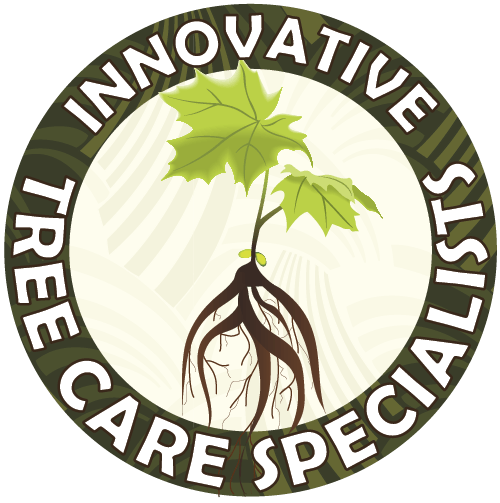Two-Lined Chestnut Borer
Two-Lined Chestnut Borer (Agrilus bilineatus) is a native wood borer that threatens the health of Wisconsin’s Oak trees. Both Oaks in the White and Red Oak groups can be attacked by TLCB, and susceptible trees can die within only a few years of infestation. Healthy Oak trees are typically not affected by TLCB, and it is drawn to stressed or otherwise unhealthy trees.
Signs & Symptoms of TLCB
TLCB can be confirmed by locating larval feeding galleries in the cambial (sapwood) tissue of dead/dying limbs, and the D-shaped exit holes that they leave when they emerge. Adult beetles are ~1/2” long, and are colored dark blue to black, with 2 yellow strips extending the length of their backs. The larva are a pale whitish color with segmented bodies, measuring ~1” when fully grown. Two protrusions are notable near the tail end of the grubs (pictures).
Limbs that dieback from TLCB will commonly “flag” and hold their dead leaves. This may be what initially catches the attention of a homeowner. Being a secondary stressor of Oaks, it is imperative to treat both the underlying cause (primary) of tree stress, along with the beetle itself. Trees under drought stress care frequently targeted, as are trees that have suffered previous years construction damage (i.e. soil compaction, root severing, etc.).
TLCB Life Cycle
The Two-Lined Chestnut Borer has only one generation per season, and it is the larval stage which causes the damage in trees. Upon emergence, which in Wisconsin is late May (around the time that Black Locust flowers), the adults begin feeding on leaves, until mating and laying eggs in July.
Eggs are laid on the bark of limbs, in the upper canopy, and hatch within a couple weeks. Common with other flatheaded borers (i.e. Bronze Birch Borer, Emerald Ash Borer, etc.), the larva tunnel into the tree’s sapwood where they begin feeding. Over time, this feeding causes a girdling of the tree’s sapwood/conductive tissue, and branch die back results. Larva overwinter in the tree, and pupae the following year prior to adult emergence.
Treating Two-Lined Chestnut Borer
Treatments for Two-Lined Chestnut Borer include both systemic insecticide injections or soil treatments. These products can highly effective if applied before the tree begins showing signs of a higher infestation (i.e. ¼ - 1/3 canopy dieback), and they provide both therapeutic (already infested) and preventative benefits. High value Oak trees may be considered for preventative treatment, especially if they are showing signs of stress. As was stated above, addressing the underlying cause of tree stress (if identifiable) will produce the best long-term results for tree health and future TLCB infestation.
Click below to set up a consultation and assessment of your Oak trees. Our arborist will be happy to provide a free initial assessment, and catered treatment plan if needed.


